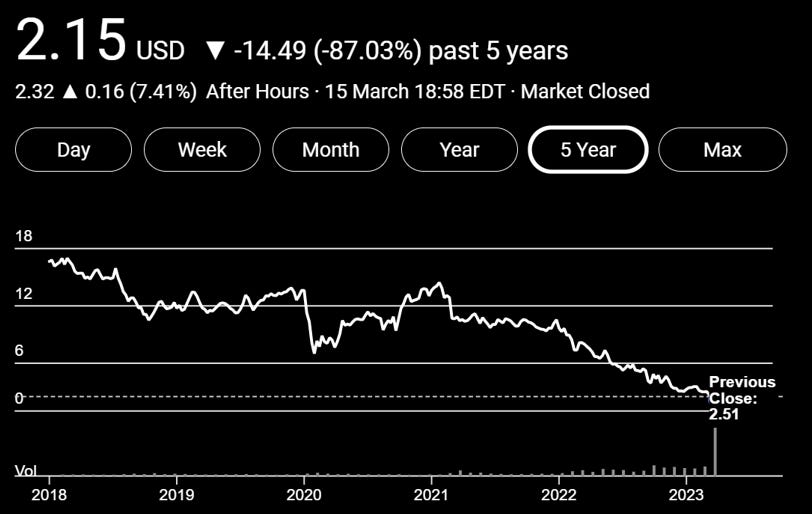Here is an intra-day chart and a five year chart of Credit Suisse (CS):
H/t CitizenFreePress.com for alerting
Not a chart that you would brag about over dinner, unless you were short of course!
Here is an article from bnnBloomberg.ca:
Global Banks Rush to Safeguard Against Credit Suisse Contagion - BNN Bloomberg
“As the day went on and the crisis convulsed global financial markets, authorities in Switzerland sought to stem the damage, releasing a statement in their evening pledging to provide Credit Suisse with emergency financing if needed.
“The trading levels have become somewhat a crisis in confidence in Credit Suisse,” said Mark Heppenstall, president of Penn Mutual Asset Management. “People are looking for any way possible to get protection.”
Wednesday’s panic was sparked by a statement from Credit Suisse’s biggest shareholder, the Saudi National Bank. When the bank’s chairman, Ammar Al Khudairy, was asked if he was willing to inject more cash into Credit Suisse, he responded “absolutely not.” That was nothing new, really — the bank has maintained that position for a while now — but it was enough to unnerve investors already on edge after three regional US banks failed in a span of days.”
Banque National de Paris (BNP) stopping accepting “novations” (issuing a new swap and cancelling the old one) where CS was part of the old swap).
Investors bought a lot of protection against a default by CS, using what are called “Credit Default Swaps” (CDS). Essentially, you buy a CDS with a maturity date, and as the risk of default increases, the price of the CDS goes up – and vice versa.
Here is some commentary on the action.
Credit Suisse Default Swaps Are 18 Times UBS, 9 Times Deutsche Bank (yahoo.com)
“(Bloomberg) -- The cost of insuring the bonds of Credit Suisse Group AG against default in the near-term is approaching a rarely-seen level that typically signals serious investor concerns.
The last recorded quote on pricing source CMAQ stood at 835.9 basis points on Tuesday. Traders were seeing prices of as high as 1,200 basis points on one-year senior credit-default swaps Wednesday morning, according to two people who saw the quotes and asked not to be named because they aren’t public. There can be a lag between pricing seen by traders and those on CMAQ at times of frantic activity.
Spreads of more than 1,000 basis points in one-year senior bank CDS is an extremely rare phenomenon. Major Greek banks traded at similar levels during the country’s debt crisis and economic slump. The level recorded on Tuesday is about 18 times the contract for rival Swiss bank UBS Group AG, and about nine times the equivalent for Deutsche Bank AG.
The CDS curve is also deeply inverted, meaning that it costs more to protect against an immediate failure at the bank instead of a default further down the line. The lender’s CDS curve had a normal upward slope as recently as Friday. Traders typically ascribe a higher cost of protection over longer, more uncertain periods.”
I am long enough in the tooth to recognise that there are many sharks circling CS hoping to rip it to pieces and take its customer base and transaction business.
CS is not even such a big fish any more with a market cap of under 10 billion bucks. JPM for example has a market cap of around 380 billion, Bank of America around 230 billion, Wells Fargo 152 billion and Citi 87 billion bucks. SVB and SB were bigger.
Of more interest and importance is the impact on the broader swap market as far as counterparty risk is concerned.
If CS has large losses on its swap book and it defaults, all the counterbalancing profits on the other banks that are counterparties to its swaps who thought they had profits, suddenly have losses instead – unless of course any losses are properly margined and collateralized. Then it’s not so much of an issue.
Suffice to say, the CS share price has only gone south since its peak in May 2007 of almost 70 bucks a share. Perhaps it and its Swiss rival UBS has at least not come under similar pressure – trading at between around 10-20 Swiss francs per share since its peak of 71 CHF back in May 2007 – it has a market capitalization of around 65 billion CHF – a little more than that in US dollars.
So far, markets are trading well, I get the feeling it is only a matter of time before central banks and weaponized regulators step in and screw things up. “Never let market forces prevent a crisis”!
PS: Pretty good article here
The Looming Quadrillion Dollar Derivatives Tsunami (blacklistednews.com)
Onwards!
Please subscribe, or donate a coffee (I drink a lot of coffee) - “God Bless You!” if you can’t or don’t want to contribute. Coffee donations here: https://ko-fi.com/peterhalligan





You mentioned the BNP Paribas maybe being vulnerable to problems at CS. I have an account with BNP, not much in it, but I keep it open as I have a small loan with them. Do you know what happens when a bank collapses? I know they can bail in our deposits over and above a certain amount but what happens if we still owe them money or have an overdraught?